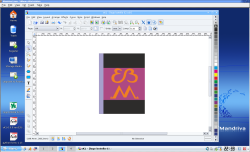Author: Federico Kereki
From its name, you’d never know that sK1 is a good vector graphics drawing program, in the same category as better-known names like Inkscape, Dia, and OpenOffice.org Draw. Moreover, sK1 includes a feature that other Linux applications lack: it can read CorelDraw’s CDR files and convert them to Linux-friendly formats.
sK1 derives its name from Sketch, a free vector graphics editor that appeared about 10 years ago. Sketch eventually became Skencil, but development seemingly got stuck (and eventually stopped) after version 0.6.17 in June 2005, when work was started on a port to GTK+. A group of Ukrainian programmers began working with the Skencil source code around 2003 and produced a fork that became sK1. The focus was to provide full support of professional printer requirements, such as the CMYK color model and PostScript and PDF formats.
The latest version of sK1 is 0.9.0, for which revisions are frequently posted. Packages are available on the site for various distributions, as is source code. The program is released under the GNU LGPL (Lesser General Public License).
Installation
sK1 is written in Python, using the Tcl/Tk package. Before trying to install sK1, check that you already have the following packages installed:
- tcl 8.5
- tk 8.5
- python-imaging
- python-liblcms
- zenity
You can then download and install the appropriate package for your distribution — but it will not be the latest available code. If you’d rather try the latest revision (but keep in mind it might be not stable), you can download it by using a Subversion client and connecting to the repository specified on the project’s download page. To build the package, run python setup.py build followed by python setup.py install. Installing the older packaged version first, and then trying the Subversion source code, is the simplest way to ensure you have everything you’ll need to create the program.
Using sK1
If you have used other vector graphics programs you will probably feel right at home with sK1, because it sports similar menus, icons, toolbars, and commands.
Start the program with sk1. Initially you get a blank screen; go to Layout -> Page to select the size you want for your drawing; then press F4, or click on the appropriate toolbar icon, or select View -> Fit to Window to scale your drawing to your screen. To select the color management scheme, either for screen or for printing, click on the small umbrella at the top right.
You can add objects with the vertical toolbar at the left. You can also arrange objects (move them to the top or bottom, layering them) by using the small icons at the bottom left. Whenever you select an object, the second toolbar from the top changes to show options appropriate for the selection.
Resizing, rotating, moving, and applying similar transformations are easy: Click on the Select icon at the left, near the top, then click on the object you want to transform. Right-clicking on the object allows you to set many properties, including fill and outline.
You can draw connected lines or set up Bezier curves, changing the curvature segment by segment — but you’ll need practice to achieve the right effect. Clicking on the Edit Mode icon, just below the Select icon, allows you to deform objects, change angles, and more.
I don’t claim to be an expert user of this kind of program, so I brought in outside help — a graphics designer with many years’ experience. He agreed the program offered all the usual functions and could probably be used with ease, after some acclimation time, by those accustumed to CorelDraw or similar programs. However, he decried the occasional crashes, and the fact some functionality was missing or incomplete. Working with unstable revisions often presents this kind of situation.
To test sK1’s touted CorelDraw import functionality, I imported some CDR (CorelDraw) files. I found no glitches in my tests, but your experience may vary, as there is no published standard for CDR, and the CDR file format may change in the future.
If you need support, you can try the sK1 forums.
In conclusion
sK1 is a potent program, although it sometimes feels slow, probably because of its Python interpreted code. The available documentation isn’t adequate, and both tutorial and higher-level manuals would be helpful. The program also crashed on me occasionally for no visible reason; changing to the latest version helped sometimes. However, sK1 is still in development; the developers last month said, “The number of people in the team is not great. The project develops very slowly, but we are optimistic.”
All in all, sK1’s advantages, including the ability both to work with CorelDraw files and to produce press-ready output, outweigh its disadvantages. However, I recommend waiting for a stable release, unless you are patient and used to unexpected problems.
Categories:
- Reviews
- Graphics & Multimedia



